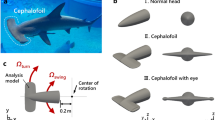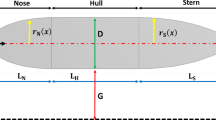Abstract
The mystacial vibrissae of pinnipeds constitute a sensory system for active touch and detection of hydrodynamic events. Harbour seals (Phoca vitulina) and California sea lions (Zalophus californianus) can both detect hydrodynamic stimuli caused by a small sphere vibrating in the water (hydrodynamic dipole stimuli). Hydrodynamic trail following has only been shown in harbour seals. Hydrodynamical and biomechanical studies of single vibrissae of the two species showed that the specialized undulated structure of harbour seal vibrissae, as opposed to the smooth structure of sea lion vibrissae, suppresses self-generated noise in the actively moving animal. Here we tested whether also sea lions were able to perform hydrodynamic trail following in spite of their non-specialized hair structure. Hydrodynamic trails were generated by a remote-controlled miniature submarine. Linear trails could be followed with high accuracy, comparable to the performance of harbour seals, but in contrast, increasing delay resulted in a reduced performance as compared to harbour seals. The results of this study are consistent with the hypothesis that structural differences in the vibrissal hair types of otariid compared to phocid pinnipeds lead to different sensitivity of the vibrissae during forward swimming, but still reveal a good performance even in the species with non-specialized hair type.







Similar content being viewed by others
References
Bleckmann H (1994) Reception of hydrodynamic stimuli in aquatic and semiaquatic animals. Fischer-Verlag. Stuttgart, New York
Bleckmann H, Breithaupt T, Blickhan R, Tautz J (1991) The time course and frequency content of hydrodynamic events caused by moving fish, frogs, and crustaceans. J Comp Physiol A 168:749–757
Crocker DE, Gales NJ, Costa DP (2001) Swimming speed and foraging strategies of New Zealand sea lions (Phocarctos hookeri). J Zool 254:267–277
Dehnhardt G (1994) Tactile size discrimination by a California sea lion (Zalophus californianus) using its mystacial vibrissae. J Comp Physiol A 175:791–800
Dehnhardt G, Kaminski A (1995) Sensitivity of the mystacial vibrissae of harbour seals (Phoca vitulina) for size differences of actively touched objects. J Exp Biol 198:2317–2323
Dehnhardt G, Mauck B (2008) Mechanoreception in secondarily aquatic vertebrates. In: Thewissen JGM, Nummela S (eds) Sensory evolution on the threshold–adaptations in secondarily aquatic vertebrates. University of California Press, Berkely, pp 295–314
Dehnhardt G, Sinder M, Sachser N (1997) Tactual discrimination of size by means of mystacial vibrissae in harbour seals: in air versus underwater. Z Säugetierkd Intern J Mamm Biol 62:40–43
Dehnhardt G, Mauck B, Bleckmann H (1998) Seal whiskers detect water movements. Nature 394:235–236
Dehnhardt G, Hyvärinen H, Palviainen A, Klauer G (1999) Structure and innervation of the vibrissal follicle–sinus complex in the Australian water rat, Hydromys chrysogaster. J Comp Neurol 411:550–562
Dehnhardt G, Mauck B, Hanke W, Bleckmann H (2001) Hydrodynamic trail following in harbor seals (Phoca vitulina). Science 293:102–104
Enger PS, Kalmijn AJ, Sand O (1989) Behavioral investigations on the functions of the lateral line and inner ear in predation. In: Coombs S, Görner P, Münz H (eds) The mechanosensory lateral line–neurobiology and evolution. Springer, New York, pp 575–587
Feldkamp SD (1987) Swimming in the California sea lion–morphometrics, drag and energetics. J Exp Biol 131:117–135
Ferner MC, Weissburg MJ (2005) Slow-moving predatory gastropods track prey odors in fast and turbulent flow. J Exp Biol 208:809–819
Fish FE, Innes S, Ronald K (1988) Kinematics and estimated thrust production of swimming harp and ringed seals. J Exp Biol 137:157–173
Fish FE, Howle LE, Murray MM (2008) Hydrodynamic flow control in marine mammals. Integr Comp Biol 48:788–800
Gellermann LW (1933) Chance orders of alternating stimuli in visual discrimination experiments. J Genet Psychol 42:206–208
Ginter CC, Fish FE, Marschall CD (2010) Morphological analysis of the bumpy profile of phocid vibrissae. Mar Mamm Sci 26(3):733–743
Hanke W, Bleckmann H (2004) The hydrodynamic trails of Lepomis gibbosus (Centrarchidae), Colomesus psittacus (Tetraodontidae) and Thysochromis ansorgii (Cichlidae) measured with scanning particle image velocimetry. J Exp Biol 207:1585–1596
Hanke W, Brücker C, Bleckmann H (2000) The ageing of the low-frequency water disturbances caused by swimming goldfish and its possible relevance to prey detection. J Exp Biol 203:1193–1200
Hanke W, Witte M, Miersch L, Brede M, Oeffner J, Michael M, Hanke F, Leder A, Dehnhardt G (2010) Harbor seal vibrissa morphology suppresses vortex-induced vibrations. J Exp Biol 213:2665–2672
Hart DP (2000) PIV error correction. Exp Fluids 29:13–22
Hyvärinen H (1989) Diving in darkness: whiskers are sense organs of the ringed seal (Phoca hispida saimensis). J Zool 218:663–678
Hyvärinen H, Katajisto H (1984) Functional structure of the vibrissae of the ringed seal (Phoca hispida Schr.). Acta Zool Fennica 171:27–30
Kalmijn AJ (1989) Functional evolution of lateral line and inner ear sensory systems. In: Coombs S, Görner P, Münz H (eds) The mechanosensory lateral line–neurobiology and evolution. Springer, New York, pp 187–215
Kastelein RA, van Gaalen MA (1988) The sensitivity of the vibrissae of a Pacific walrus (Odobenus rosmarus divergens). Aquat Mamm 14:123–133
Mauck B, Eysel U, Dehnhardt G (2000) Selective heating of vibrissal follicles in seals (Phoca vitulina) and dolphins (Sotalia fluviatilis guianensis). J Exp Biol 203:2125–2131
Pohlmann K, Grasso FW, Breithaupt T (2001) Tracking wakes: the nocturnal predatory strategy of piscivorous catfish. Proc Natl Acad Sci 98:7371–7374
Rice FL, Mance A, Munger BL (1986) A comparative light microscopical analysis of the sensory innervation of the mysticial pad. 1. Innervation of vibrissal follicle-sinus complexes. J Comp Neurol 252:154–174
Schulte-Pelkum N, Wieskotten S, Hanke W, Dehnhardt G, Mauck B (2007) Tracking of biogenic hydrodynamic trails in harbour seals (Phoca vitulina). J Exp Biol 210:781–787
Stelle LL, Blake RW, Trites AW (2000) Hydrodynamic drag in Steller sea lions (Eumetopias jubatus). J Exp Biol 203:1915–1923
Stephens RJ, Beebe IJ, Poulter TC (1973) Innervation of vibrissae of California sea lion, Zalophus californianus. Anat Rec 176:421–441
Vester HI, Folkow LP, Blix AS (2004) Click sounds produced by cod (Gadus morhua). J Acoust Soc Am 115:914–919
Watkins WA, Wartzok D (1985) Sensory biophysics of marine mammals. Mar Mamm Sci 1:219–260
Weissburg MJ (2000) The fluid dynamical context of chemosensory behavior. Biol Bull 198:188–202
Westerweel J (1997) Fundamentals of digital particle image velocimetry. Meas Sci Technol 8:1379–1392
Wieskotten S, Dehnhardt G, Mauck B, Miersch L, Hanke W (2010a) Hydrodynamic determination of the moving direction of an artificial fin by a harbour seal (Phoca vitulina). J Exp Biol 213:2194–2200
Wieskotten S, Dehnhardt G, Mauck B, Miersch L, Hanke W (2010b) The impact of glide phases on the trackability of hydrodynamic trails in harbour seals (Phoca vitulina). J Exp Biol 213:3734–3740
Willert CE, Gharib M (1991) Digital particle image velocimetry. Exp Fluids 10:181–193
Williams TM, Kooyman GL (1985) Swimming performance and hydrodynamic characteristics of harbor seals (Phoca vitulina). Physiol Zool 58:576–589
Wilson B, Batty RS, Dill LM (2004) Pacific and Atlantic herring produce burst pulse sounds. Proc R Soc Lond B 271:S95–S97
Acknowledgments
We thank the directors and staff of Zoo Duisburg for their great cooperation. This study was supported by grants of the Volkswagenstiftung to GD, and the German Research Foundation (DFG) to GD and WH (SPP 1207). The experiments were carried out under the guidelines established by the European Communities Council Directive of 24 November 1986 (86/609/EEC).
Author information
Authors and Affiliations
Corresponding author
Rights and permissions
About this article
Cite this article
Gläser, N., Wieskotten, S., Otter, C. et al. Hydrodynamic trail following in a California sea lion (Zalophus californianus). J Comp Physiol A 197, 141–151 (2011). https://doi.org/10.1007/s00359-010-0594-5
Received:
Revised:
Accepted:
Published:
Issue Date:
DOI: https://doi.org/10.1007/s00359-010-0594-5




